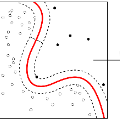Most cross-domain unsupervised Video Anomaly Detection (VAD) works assume that at least few task-relevant target domain training data are available for adaptation from the source to the target domain. However, this requires laborious model-tuning by the end-user who may prefer to have a system that works ``out-of-the-box." To address such practical scenarios, we identify a novel target domain (inference-time) VAD task where no target domain training data are available. To this end, we propose a new `Zero-shot Cross-domain Video Anomaly Detection (zxvad)' framework that includes a future-frame prediction generative model setup. Different from prior future-frame prediction models, our model uses a novel Normalcy Classifier module to learn the features of normal event videos by learning how such features are different ``relatively" to features in pseudo-abnormal examples. A novel Untrained Convolutional Neural Network based Anomaly Synthesis module crafts these pseudo-abnormal examples by adding foreign objects in normal video frames with no extra training cost. With our novel relative normalcy feature learning strategy, zxvad generalizes and learns to distinguish between normal and abnormal frames in a new target domain without adaptation during inference. Through evaluations on common datasets, we show that zxvad outperforms the state-of-the-art (SOTA), regardless of whether task-relevant (i.e., VAD) source training data are available or not. Lastly, zxvad also beats the SOTA methods in inference-time efficiency metrics including the model size, total parameters, GPU energy consumption, and GMACs.
翻译:大部分跨部不受监督的视频异常检测(VAD)工作假设,至少有少量与任务相关的目标域培训数据可以从源头到目标域进行调适。然而,这需要终端用户努力进行模型调整,因为最终用户可能更喜欢使用“出箱”的系统。为了应对这些实际情景,我们确定了一个新的目标域(推论-时间) VAD 任务,那里没有目标域培训数据。为此,我们提议了一个新的“点点点点 点 点 点 点 点 点 点 点 点 点 点 点 点 点 点 点 点 点 点 点 点 点 点 点 点 点 点 点 点 点 点 点 点 点 点 点 点 点 点 点 点 点 点 点 点 点 点 点 点 点 点 点 点 点 点 点 点 点 点 点 点 点 点 点 点 点 点 点 点 点 点 点 点 点 点 点 点 点 点 点 点 点 点 点 点 点 点 点 点



